Table Of Contents
- Historical Development of constitution of India
- Timeline of British rule in India
- Important Acts Passed during British India and their Provinces
- Rule in India (1773-1858)
- Rule in India (1858-1947)
Historical Development of Constitution of India
During 200 years of British rule in India various acts were passed in order to have a better control over the administration of this diversified large land under both Company and the Crown rules. These acts have a great influence on country’s present political structure and various constitutional provisions.
Timeline of British Rule in India
1. The Company Rule(1773-1857):
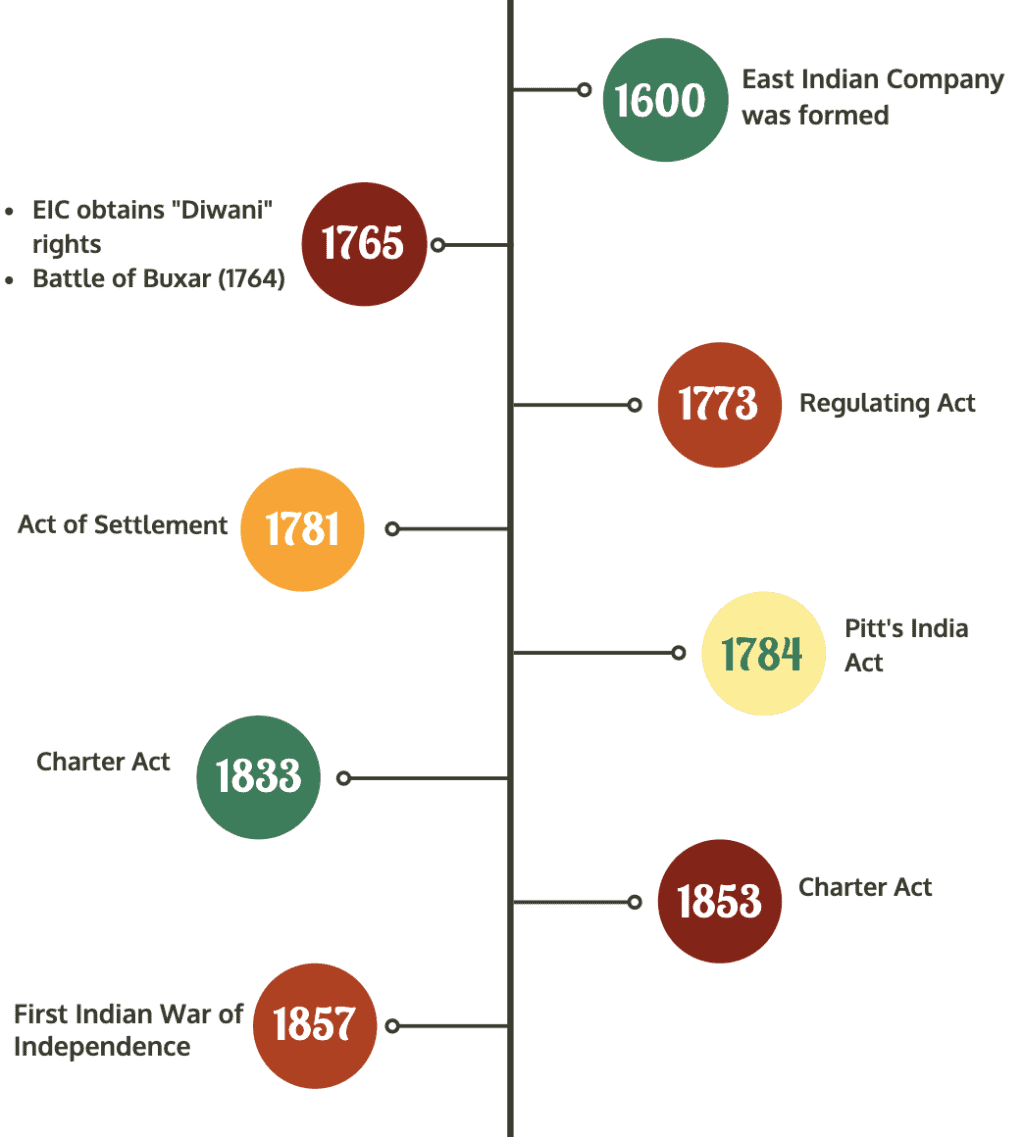
2. The Crown Rule (1858-1947)
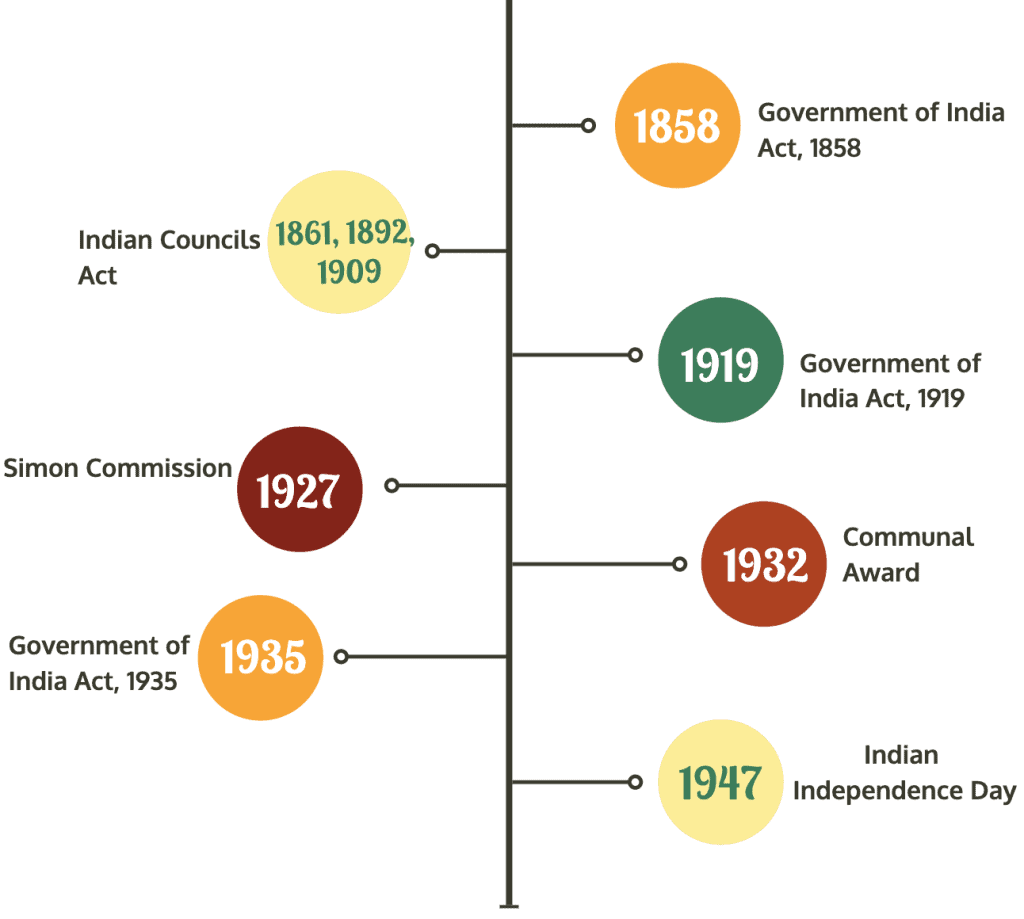
➢ Important Acts passed during British India and their Provisions:
1. Rule in India (1773-1858)
(i) Regulating Act, 1773
Features of the Act:
- The act was the first attempt to regularize company affairs in India.
- It laid the foundation of Central Administration in India.
- Governor of Bengal became Governor-General of Bengal (Lord Warren Hastings was the first Governor General of Bengal).
 Warren Hasting
Warren Hasting - Created Executive Council of 4 members to assist Governor General of Bengal.
- Made Governors of Madras and Bombay presidencies subordinate to Governor-General of Bengal.
- Provisioned for setting up the Supreme Court of Calcutta with 1 Chief justice and 3 other judges.
- Prohibited the servants of company from indulging in any private trade and accepting bribes from locals.
- Provisioned for the Court of Directors of the Company to report the British Government regarding Company’s revenue, civil and military affairs in India.
(ii) Act of Settlement or Amending Act, 1781
Features of the Act:
- This act was passed to amend the Regulation Act, 1773.
- Safeguarded the Governor General and its council from the jurisdiction of the Supreme Court. Also provided immunity to the servants for their official actions.
- Exempted matters related to revenue of the Company from jurisdiction of Supreme Court.
- Required the Supreme Court to administer the personal law of the defendant.
- Empowered the Governor General and its Council to frame regulations regarding Provincial Courts and Councils.
(iii) Pitt’s India Act, 1784
Features of the Act:
- Established a system of Double Government. Provided for Court of Director to manage Company’s commercial affairs while a new body called Board of Control to manage its political affairs.
- Empowered the Board of Control to supervise and direct civil and military operations and revenues of the British possessions in India.
Significance of the Act:
- First time acknowledged Indian Territory under control of the company as the British possessions in India.
- British government became the Supreme Controller of Company’s affairs and administration in India.
(iv) Charter Act, 1813
Features of the Act:
- Abolished the trade monopoly of the Company in India except trade in tea and trade with China.
- Allowed Christian missionaries to come to India and start their religious awakening in India.
- Authorized Local Governments in India to levy taxes on people of India.Question:
(v) Charter Act, 1833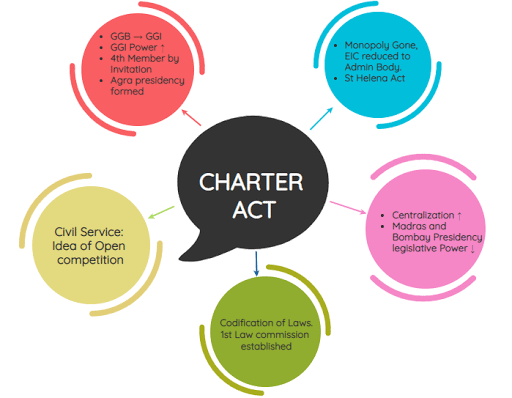 Features of the Act:
Features of the Act:
- Made Governor-General of Bengal as the Governor-General of India and vested all civil and military powers in him. (Lord William Bentinck became the first Governor-General of India)
- Empowered Governor-General of India with the exclusive legislative powers of the entire British India.
- The Company became a purely administrative body.
(vi) Charter Act, 1853
Features of the Act:
- Separated legislative and executive functions of the Governor-General’s Council.
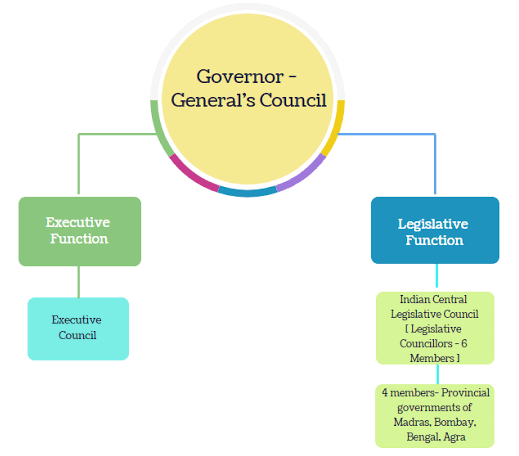
- Provided for a separate 6 members Indian Legislative Council to function as mini parliament.
- Provisioned for open competition system for Indian Civil Services for Indians also.
- Introduced local representation in the Indian (Central) Legislative Council. (out of 6 members 4 to be appointed by the local governments of Madras, Bombay, Bengal and Agra)
2. Rule in India (1858 to 1947)
(i) Government of India Act, 1858:
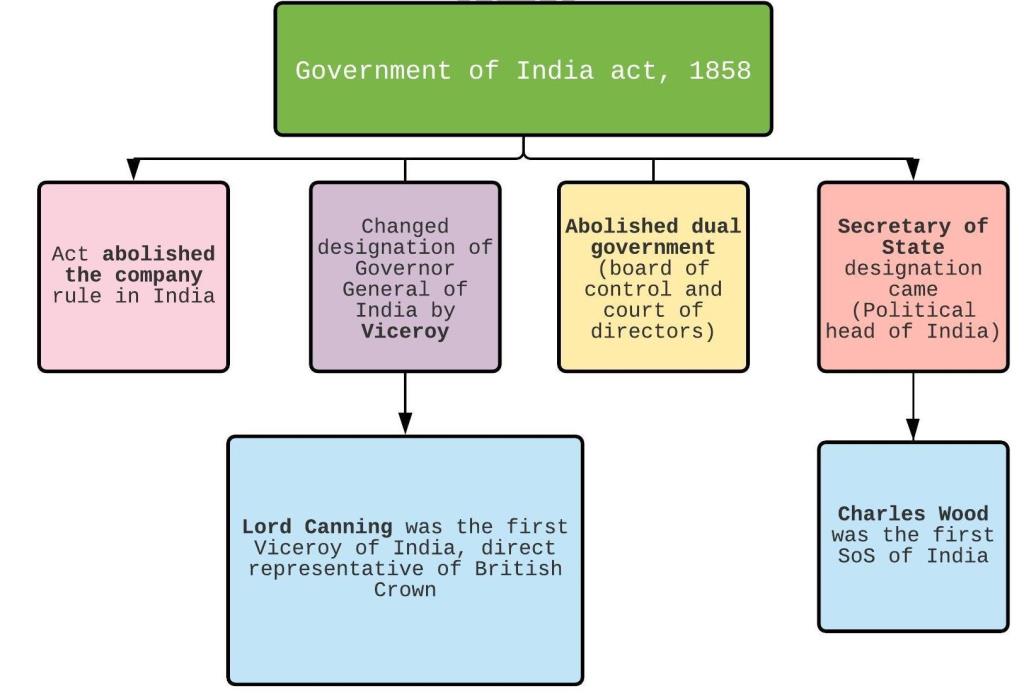
- Post 1857 revolt British Government took control over entire territory of India under Company rule. The act is also known as the Act of Good Government of India.
Features of the Act:
- Changed the post of Governor-General of India to Viceroy of India and made him the representative of British Crown in India. (Lord Canning was the first Viceroy of India)
- Abolished the Board of Control and Court of Directors.
- Created office of Secretary of State for India, vested with complete authority and control over Indian administration.
- Created a 15 member Council of India to assist the Secretary of State for India.
(ii) Indian Councils Act, 1861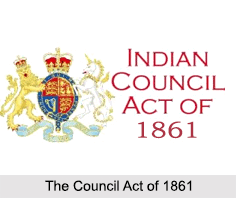
Features of the Act:
- Empowered the Viceroy to nominate some Indians as the non-official members under his expanded council. (Lord Canning nominated 3 Indians: the Raja of Benaras, the Maharaja of Patiala and Sir Dinkar Rao)
- Decentralized legislative powers by empowering the Bombay and Madras Presidencies.
- Provided for the establishment of new legislative councils for Bengal, North-Western Provinces and Punjab. The act established the Portfolio system in Indian administration. It empowered the Viceroy to make rules and orders for better functioning of the Council and made members of the council in-charge of and authorized to issue orders regarding one or more departments of the Government allocated to them.
- Empowered the Viceroy of India to issue ordinances in emergency without the concurrence of the legislative council and with a validity of 6 months.
(iii) Indian Councils Act, 1892
Features of the Act:
(a) Increased the number of non-official members in the Central and Provincial legislative councils.
(b) Empowered the legislative councils with discussing budget and addressing questions to the executive.
(c) Provided for the nomination of some non-official members of the:
- Central Legislative Council by the viceroy on the recommendation of the Provincial Legislative Councils and the Bengal Chamber of Commerce, and
- that of the Provincial Legislative Councils by the Governors on the recommendation of the district board, municipalities, universities, trade associations, zamindars and chambers.
(iv) Indian Councils Act, 1909
- Also known as Morley-Minto Reforms.
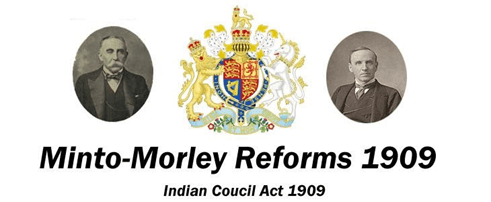
- The number of members in the Central Legislative Council was increased from 16 to 60 and the number of members in the Provincial Legislative Council was also increased but not uniformly.
- Empowered the members of legislative councils at both levels to ask supplementary questions, move resolutions on the budget, etc.
- Provided for the association of Indians with the executive councils of the Viceroy and Governors. (Satyendra Prasad Sinha was the first Indian to join the Viceroy’s executive council as the Law member)
- Introduced system of communal representation for Muslims and separate electorate for them.Question:
(v) Government of India Act, 1919
Features of the Act: - Also known as the Montagu-Chelmsford Reforms.
- Separated Central and Provincial subjects.
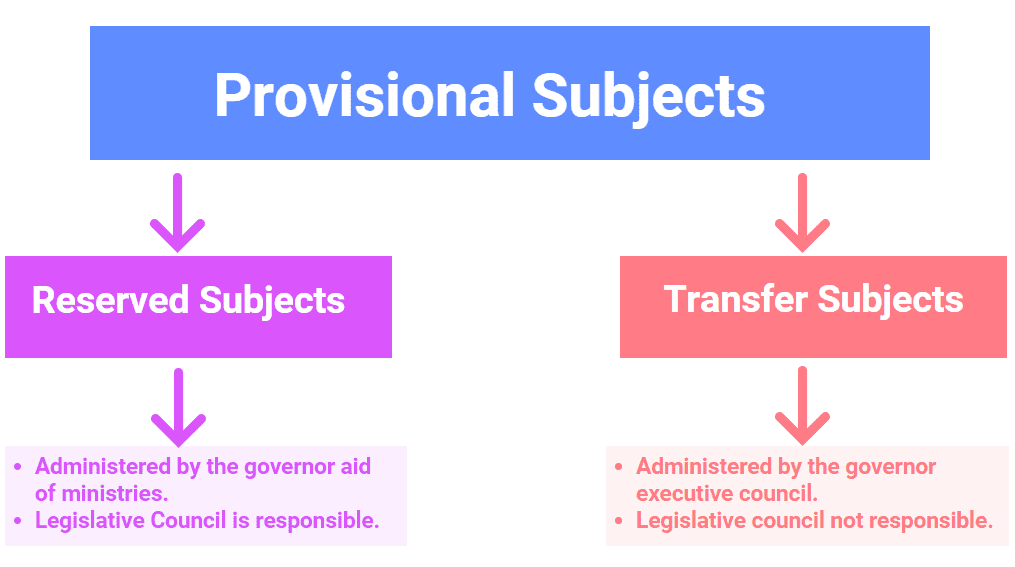 Division of Provincial Subjects
Division of Provincial Subjects - Provincial subjects were further divided into transferred subjects and reserved subjects. Transferred subjects were to be governed by the Governor with the aid of ministers of the legislative council and the reserved subjects by Governor with his executive council.
- Introduced bicameralism and direct elections in the country.
- Provisioned for 3 out of 6 members of the Viceroy’s executive council were to be Indian. Provided for separate electorates for Sikhs, Indian Christians, Anglo-Indians and Europeans also.
- Granted franchise to a limited number of people based on property, tax or education.
- Created new office of High Commissioner for India in London.
- Provided for setting up a Central Service Commission for recruiting civil servants.
- Separated provincial budgets from the Central budget and authorized the provincial legislatures to enact their budgets.
Significance of the Act:
- This was though intended towards a responsible government in British India but the role of the elected members of the legislature was mere advisory. Viceroy retained control of the central government.
- Later with the passage of Rowlatt Act the government suppressed voices of Indians as it empowered the Government to imprison any person without trial and conviction a court of law.
- Simon Commission was then appointed in 1927 which was opposed greatly by Indians.Question:
(vi) Government of India Act, 1935
Events leading to Act: - Incorporating the recommendations of Simon Commission (1930)
- Civil Disobedience Movement (1930)
- Recommendations of Round Table Conferences (1930, 31 and 32)
- Gandhi-Irwin Pact
- Poona Pact between Gandhi Ji and B.R. Ambedkar (1932)
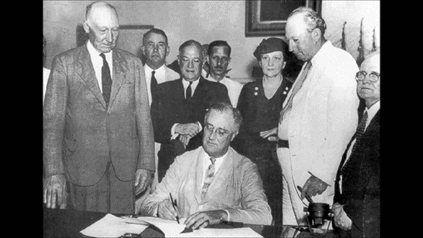
Features of the Act:
- Provided for the establishment of an All India Federation consisting of provinces and princely states as units.
- Divided powers into three lists: Federal list (for Centre, with 59 items), Provincial list (for Provinces, with 54 items) and the Concurrent list (for both, with 36 items). The Viceroy was empowered with all the residuary powers.
- Abolished dyarchy in the provinces and introduced provincial autonomy. It introduced responsible Governments in provinces where the Governor needed to work on advice of ministers responsible to the provincial legislature.
- Provided for adoption of dyarchy at the Centre. Federal subjects were divided into transferred subjects and reserved subjects.
- Introduced bicameralism in 6 out of 11 provinces (Bengal, Bombay, Madras, Bihar, Assam and the United Provinces).
- Divided Federal Budget in 80 percent non-votable part which could not be discussed or amended in the legislature and the remaining 20 percent of the whole budget which could be discussed or amended in the Federal Assembly.
- Provisioned for separate electorates for depressed classes (Scheduled Castes), women and labour. It extended franchise and about 10 percent of the total population got voting rights.
- Abolished the Council of India.
- Established Reserve Bank of India to control currency and credit of the country.
- Established Federal Public Service Commission, Provincial Public Service Commission and Joint Public Service Commission.
- Provided for setting up a Federal Court.
Significance of the Act:
- Reflected the ambiguity of British commitment to dominion status for India.
- Discussed nothing about the citizens’ rights.
- No major impact on the powers of the Governor-General and that of Governors in the provinces.
- Communal electorate further divided the Indian society.
- The Constitution so created was rigid and the power to amend was reserved with the British parliament.Question:
(vii) Indian Independence Act, 1947
Based on the demands from Muslim league for separate nation for Muslims, the then Viceroy of India, Lord Mountbatten pot forth the partition plan, known as the Mountbatten Plan. The plan was accepted by both Congress and Muslim league. The Indian Independence Act of 1947 gave immediate effect to the plan. Features of the Act:
Features of the Act: - Ended British rule in India and declared India to be independent and sovereign state from August 15, 1947.
- It provisioned for partition of India and Pakistan as two independent dominions with right to secede from the British Commonwealth.
- It empowered the Constituent Assemblies of the two nations to frame and adopt any constitution of their respective nations and to repeal any act of the British Parliament including the Independence Act itself.
- It abolished the office of Secretary of State for India and transferred his powers to the Secretary of State for Commonwealth Affairs.
- It deprived the British Monarch of his right to veto bills or ask for reservation of certain bills for his approval.
- It designated the Governor-General of India and provincial governors as constitutional (nominal) heads of the states.
- It dropped the title of Emperor of India from the royal titles of the King of England.
- It discontinued the appointment to Civil Services and reservation of posts by Secretary of State of India.
- Crown ceased to be the Source of Authority.
Significance of the Act:
- As per the provision under the Act, India became an independent nation on 15th August 1947 and the British rule India came to an end.
- Lord Mountbatten became the last Governor General of British India and the first Governor-General of the new dominion of India.
- J.L. Nehru became the first Prime Minister of the Country.
- The Constituent Assembly of India constituted in 1946 became the Parliament of Independent India.
- As per the provision of the act the princely states were free to join any of the two dominions or set themselves free which led to a huge task of unification of the country and curb the seceding tendencies.
Comments
Post a Comment